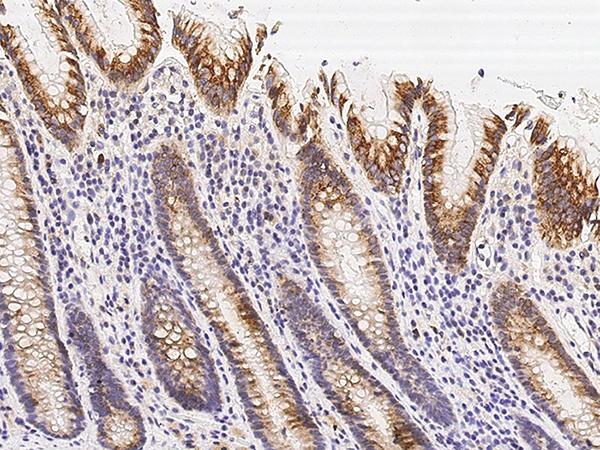-
Product Name
Anti-TNFSF10/TRAIL/APO-2L (CD253) antibody
- Documents
-
Description
Rabbit polyclonal to TNFSF10/TRAIL/APO-2L (CD253)
-
Tested applications
ELISA, IHC-P
-
Species reactivity
Human TNFSF10 / TRAIL / APO-2L
-
Alternative names
TL2 antibody; APO2L antibody; CD253 antibody; TRAIL antibody; Apo-2L antibody; TL2 antibody; Ly81 antibody; Trail antibody; APO-2L antibody; AI448571 antibody; A330042I21Rik antibody; A330042I21Rik antibody; AI448571 antibody; APO2L antibody; Apo-2L antibody; APO-2L antibody; CD253 antibody; Ly81 antibody; TL2 antibody; TL2 antibody; Tnfsf10 antibody; TNFSF10 antibody; Trail antibody; TRAIL antibody
-
Isotype
Rabbit IgG
-
Preparation
Produced in rabbits immunized with purified, recombinant Human TNFSF10 / TRAIL / APO-2L (rh TNFSF10 / TRAIL / APO-2L; NP_003801.1; Thr 95-Gly 281). TNFSF10 / TRAIL / APO-2L specific IgG was purified by Human TNFSF10 / TRAIL / APO-2L affinity chromatography.
-
Clonality
Polyclonal
-
Formulation
0.2 μm filtered solution in PBS with 5% trehalose
-
Storage instructions
This antibody can be stored at 2℃-8℃ for one month without detectable loss of activity. Antibody products are stable for twelve months from date of receipt when stored at -20℃ to -80℃. Preservative-Free.
Sodium azide is recommended to avoid contamination (final concentration 0.05%-0.1%). It is toxic to cells and should be disposed of properly. Avoid repeated freeze-thaw cycles. -
Applications
ELISA: 0.1-0.2 μg/mL
This antibody can be used at 0.1-0.2 μg/mL with the appropriate secondary reagents to detect Human TNFSF10. The detection limit for Human TNFSF10 is approximately 0.00975 ng/well.
IHC-P: 0.1-2 μg/mL
-
Validations

TNFSF10 / TRAIL / APO-2L / CD253 Antibody, Rabbit PAb, Antigen Affinity Purified, Immunohistochemistry
Immunochemical staining of human TNFSF10 in human colon with rabbit polyclonal antibody (1 µg/mL, formalin-fixed paraffin embedded sections).
-
Background
Tumor necrosis factor ligand superfamily member 10 (TNFSF10), also known as TNF-related apoptosis-inducing ligand (TRAIL), Apo-2 ligand, and CD253, is a cytokine that belongs to the tumor necrosis factor (TNF) ligand family. TNFSF10 / Apo-2L / CD253 functions as a ligand that induces the process of cell death called apoptosis. TNFSF10 / TRAIL shows homology to other members of the tumor necrosis factor superfamily. As one member of the cluster of differentiation system, TNFSF10 / CD253 is commonly used as cell markers in immunophynotyping. Different kinds of cells in the immune system can be identified through the surface CD molecules which associating with the immune function of the cell. There are more than 320 CD unique clusters and subclusters have been identified. Some of the CD molecules serve as receptors or ligands important to the cell through initiating a signal cascade which then alter the behavior of the cell. Some CD proteins do not take part in cell signal process but have other functions such as cell adhesion TNFSF10 / Apo-2L / CD253 / TRAIL binds to several members of TNF receptor superfamily including TNFRSF10A / TRAILR1, TNFRSF10B / TRAILR2, TNFRSF10C / TRAILR3, TNFRSF10D / TRAILR4, and possibly also to TNFRSF11B/OPG. The activity of TNFSF10 / TRAIL may be modulated by binding to the decoy receptors TNFRSF10C / TRAILR3, TNFRSF10D/TRAILR4, and TNFRSF11B/OPG that cannot induce apoptosis. The binding of this protein to its receptors has been shown to trigger the activation of MAPK8 / JNK, caspase 8, and caspase 3. Alternatively spliced transcript variants encoding different isoforms have been found for this gene.
-
References
- Song C, et al. (2005) TRAIL (CD253), a new member of the TNF superfamily. J Biol Regul Homeost Agents. 19(1-2): 73-7.
- Kuribayashi K, et al. (2008) TNFSF10 (TRAIL), a p53 target gene that mediates p53-dependent cell death. Cancer Biol Ther. 7(12): 2034-8.
- Wiley SR, et al. (1995) Identification and characterization of a new member of the TNF family that induces apoptosis. Immunity. 3(6): 673-82.
Related Products / Services
Please note: All products are "FOR RESEARCH USE ONLY AND ARE NOT INTENDED FOR DIAGNOSTIC OR THERAPEUTIC USE"
